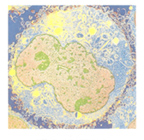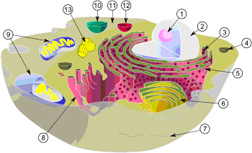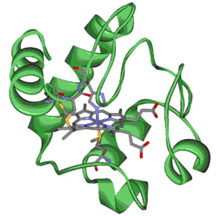


This image is a view of a human cell taken from an electron microscope. The human cell is the fundamental element of living organisms. It is so tiny that it cannot be seen through a conventional microscope. This cell is filled with nutrients (various chemicals, metals, and acids that exist in a biological state).
It is the cell that is damaged when an injury occurs and it is the cell that responds to the infrared energy that is delivered from a therapeutic laser.
The cell consists of highly organized physical structures which are called organelles.
These components are surrounded by an elastic membrane composed of proteins and lipids, referred to as the cell wall. The cell at the center is the nucleus.


Mitochondria is present in each cell. these are oval membranes that consist of cavities that contain large quantities of dissolved enzymes that extract energy from nutrients.
Schematic of typical animal cell, showing sub-cellular components. Organelles: (1) nucleolus (2) nucleus (3) ribosome (4) vesicle (5) rough endoplasmic reticulum (ER) (6) Golgi apparatus (7) cytoskeleton (8) smooth ER (9) mitochondria (10) lysosome (11) cytoplasm (12) peroxisome (13) centrioles

The Cytochrome is a membrane- bound "chemo protein" within the Mitochondria. It contains chemo groups and carry out electron transport.
Current thinking is ...when infrared particles are absorbed in the Mitochondria, it is the cytochrome that transports the electrons into chemical activity associated with replication that causes cellular growth or cellular recovery.
Copyright by wong way tm corporation, august 2007